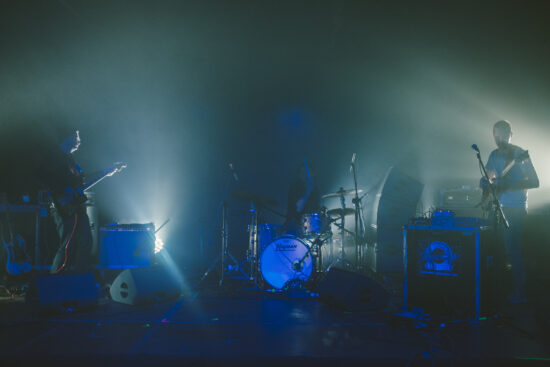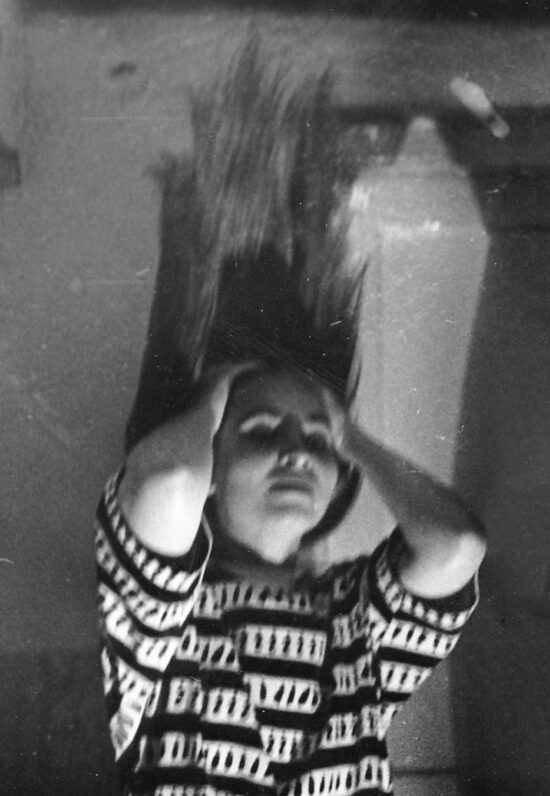Post-punk improvisations, jazz metal, doom metal flirting with folk or algorithmic electronics – welcome to a showcase of the youngest Russian scene in all its eclectic glory.
Translation: Aleksandra Szkudłapska
Through our constant focus on the West, Poles tend to overlook the latest developments on Eastern scenes.Konstanty Usenko offers an interesting reconnaissance, either through his books (sadly only in Polish for the time being) or his essays, where he describes the alternative Russian scene – from the beginnings of punk rock and new wave, to the latest productions that combine hip hop and electro. However, this scene is worth exploring on your own too, and I have to say that nothing absorbed me to such an extent this year as albums issued in Russia – eclectic, drawing from various aesthetics, and often very original. I regularly browse Bandcamp looking for new music, and as I was listening to some of these artists, I immediately thought about the term New Weird Russia (a reference to New Weird America, and other similar movements). As I’ve discovered thanks to Google, it has already been employed in a series of texts published by The Quietus.However, there are so many musical phenomena on the Russian scene that I’d like to borrow that header to showcase ten magnificent albums:
KATE NV, Room for the Moon, RVNG Intl
It all started with her this year. Ekaterina Shilonosova’s third album is different from the previous one – the minimalist, synthesizer-based для FOR. Even the title, Room for the Moon, shows just how much the musicianwants to fit in a single record. She manages both: to fit a huge moon in a small room, and juxtapose a number of elements within one coherent work. Shilonosova builds a hypertextual story, singing in Russian, English and French, and drawing from electronica, jazz, disco and art-rock. This seemingly old-school music transports us back in time to cartoons and memories from the 1970s and 80s, Russian conceptualism, and the Social Realist – or plain surrealist – reality. It all comes together in a fairy-tale-like, nostalgic aura (this atmosphere is further strengthened by Shilonosova’s brilliantly stylised videos). The album combines the light-heartedness of pop, guitar parts that bring to mind prog-rock, post-punk twists and turns in the style of David Byrne (the brilliant “Ça Commence Par”), and Japanese animated films (the moon in the title is also a reference to Sailor Moon). On the one hand, this album is rooted in avant-pop, on the other, in the aesthetics of the Russian borderlines; it resembles the soundtrack of animated films, but is ideally suited for radio airtime (I heard one track in a clothing chain store). It offers both entertainment and reflection – when Shilonosova touches upon subjects such as the world moving forward at breakneck speed, the passing of time or people’s herd instinct, her contemporary narrative mixed with phantasmagorical images of childhood turns into a truly captivating record of the here and now.
ГШ (Glintshake), Flexible Schedule, Incompetence
Kate NV also plays in ГШ (Glintshake), which issued two albums this year: first a concert recording, and now a studio album, albeit a largely improvised one. Although they visited Poland a few years ago, I didn’t manage to see them at the time, so I’m left with their session for KEXP. Already the 21-minutes-long title piece shows that these improvisations are thoroughly thought-out – whether in the simple core played by the drums and bass, supplemented with the guitar and flute, math-rock passages that bring to mind Ponytail, or Shilonosova’s vocal repetitions, offering a tongue-in-cheek list of ecological, developmental and professional ideals of contemporary humans. But that’s not all: the quintet even explores post-punk regions in the vein of Talking Heads or The Ex. In “Circus in the Mountains”, the shortest track on the record, they sound like a travelling troupe juggling new wave rhythms and quasi-jazz flourish. “Unstable Object” is an abstract, Baudelaire-esque, urban observation of reality unfolding against sparse instrumentation that grows into a fully-blown guitar orchestra. The closing track, with the repetition of “didn’t do anything good again” (in Russian, of course), reminds me of the pessimism of Trupa Trupa, showing the senselessness of the universe, the fluid reality slipping through our fingers, de facto annulling the idealised tracks from the opening of the record. All the while to the accompaniment of broken guitar riffs. ГШ (Glintshake) combine art-rock influences, breakneck post-punk riffs, freedom, and improvisation, but manage to lock these crazy sonic experiments within a convincing framework. Their music is full of unbridled vigour and non-cliched hit factor. For me, this is the most interesting guitar album of the year.
Inturist, Action!, Incompetence
Another member of Glintshake is Jenya Gorbunov, founder of the Incompetence label and distinguished member of the alternative Russian scene, recording, among others, under the moniker Intourist. His musical path on Action! begins where his original formation ends their sonic observations of urban spleen. There’s no room for guitars here: Gorbunov recorded the album alone, and this introspective, outsider atmosphere struck me as really convincing. His electronica is strongly marked with an algorithmic formula, and based on his highly manipulated vocals. It would make an ideal soundtrack for post-pandemic wanderings around empty cities. Subsequent tracks refer to various spaces: parking lots, petrol stations, parks or deserted corridors, as indicated by the titles themselves – locations for a plot, as if taken straight out of a screenplay. I listen to them and, in my mind’s eye, see a figure statically moving against this background, taking in the surroundings in an impassive manner. Yet this dehumanised music has an organic feel to it, because everything you hear has its source in Gorbunov’s voice disintegrated into primary parts. Action! could well form part of the Orange Milk Records catalogue or serve as a soundtrack to John Carpenter’s horror films. This music is alienated, and yet intimate, devoid of rhythm, and yet with a clearly distinguishable pulse that pushes the narrative forward.Overlapping voice layers serve as the basis for harmonic, rhythmical structures that develop into long, intriguing, cinematic and vivid compositions.
Andrey Lee, Объект и среда, Incompetence
Gorbunov played in Interchain together with Andrey Lee. The latter’s latest album, Объект и среда (English:Object and Environment) is an abstract journey across club music that sways between strict rhythmical structures. Synthetic cumulations of percussion instruments and acid-fuelled synths, with melodies that are merely a tentative suggestion, create an uncanny music conglomerate that seems to be a geometric representation of the cover image. Peculiar musical appositions reflect the titles of tracks that combine spaces and objects, such as “Inhabitants of a room filled with fuel oil”, “Red rubber surface on a cloudy day” or “Flying over the landscape with chaotically lying pipes”.
This is a surreal juxtaposition that Lee tries to translate into music: the conglomerate of ambient, electro, elements of techno, dub, krautrock and glitch comes with an added visual layer that brings another dimension to the sound. It was created with Readymag designers to enhance the effect of music – while they don’t have a direct influence on what we hear, these animated, geometrical visuals that we can create on our own stimulate a different perception of music. The original player on the website demonstrates a symbiosis of sound and image (you can read more about it here), an out-of-the-box approach that goes beyond not just elements of structured club music, but also its usual reception (this is particularly interesting under lockdown conditions, when we can create an audiovisual show on our own computer).
Jenya Kukoverov, Hairy Finger & Invisible Clarinets, TOPOT
Jenya Kukoverov, who plays in the cult alternative band I.H.N.A.B.T.B., would easily make friends with Ariel Pink or Julian Lynch. This is an unusual release for TOPOT, a label I’ve already written about this year, because it’s more song-based, psychedelic, and could be filed under lo-fi or indie rock. For the most part, the musician is armed with the clarinet, which often substitutes the guitar on this album. Encouraged to try his hand at playing the clarinet during the lockdown, Kukoverov added bass, percussion instruments, beats, xylophone, Vermona and a whole bunch of loops to create a colourful blend of music with slightly surfer overtones. I guess that’s the kind of music we need to not go crazy in our weird times. These are pop songs with clear rhythm and melodies – without lyrics, but high on the absurd served by the multi-instrumentalist, at times reminiscent of Mitch & Mitch. This is particularly clear in the crazy free jazz twists and turns of “ZX Spectrum Conductor” or clarinet cries and wheezes in “Canyon of Tranquility”. Music-wise, we get an entire sonic kaleidoscope in the squeaky (clarinet), lo-fi (beats) vein – do bear in mind that this is still one musician sounding like an entire orchestra (“Losing the Ground Under My Feet”). Time and again, the album offers us absurd moments or a tropicalia-like atmosphere (“Lianas”). Kukoverov may seem like a joker, a contemporary version of Frank Zappa, but once you form a deeper bond with his music, it becomes clear that this is a mature composer, who – through his involvement in various groups – has developed his own original language.
Misha Sultan × Пурпурный Дядя, Кураж, Hair DL
Although the album recorded by Misha Sultan and Purpurnyi Dyadya (English: Purple Uncle) begins with what sounds like rhythmical tribal music, it goes through various changes of mood and style. The duo lead us through the dry sound of drums and melodious flute, but as we listen, these acoustic elements begin to enter into a dialogue with synthesiser forms, and percussion is replaced by beats. The more traditional parts are almost imperceptibly interspersed with drone layers and a whole tissue of small percussion instruments (“Болотная Птица”), which gradually disappear behind electronic synths, with the initial lightness giving way to weight (“Атом”). Кураж sounds like outsider music – on the one hand, it brings to mind the Slovenian Sirom or Karpaty Magiczne, as it’s strongly rooted in primeval, pure sounds. On the other hand, the synthesiser parts remind me of the entire hauntological movement, particularly the first albums by Oneohtrix Point Never or Emeralds. This is kosmische Musik, but not in its clear-cut incarnation: trance music based on rhythm and synthesisers; cosmic compositions, also in their strictly acoustic format, when wind instruments are combined with simple percussion elements. Imagine Księżyc meet Can – this album is situated somewhere along the intersection of these two associations.
Brom, Dance with an idiot, Trost / Brom & Toshinori Kondo, The Sea is Rough, Bocian
In theory, Brom’s point of departure is free and jazz music, but the practice is completely different. Electronics and amplified bass elevate them to an entirely different level: that of the constant ebb and flow of Yaroslav Kurilo’s broken rhythmical structures, the wall of sound built by Dmitriy Lapshin’s guitar, the spatial backgrounds of Felix Mikensky’s electronics and Anton Ponomarev’s lengthy sax phrases in the foreground.You won’t hear too much raw jazz on this album, because in terms of the mastering, the record sounds more (pardon my French) rock at times. The guitar delivers powerful blows, which comes to light particularly in the title track – a broken dance tune, at times lively, at times swinging like a waltz in the finale. “Demons” has a metal edge, with steamrolling percussion and frenzied saxophone, “Goodbye, White Rhino!” verges on post-hardcore, and the swinging “Salty Peanuts” has a clearly post-punk ending. The ironic titles remind us not to take this whole thing too seriously. As a result, the balance is maintained: the powerful sound, the constant playing with conventions, and tracks with no trace of waffling sound invigoratingly fresh.
Supplementing Brom’s musical horizons is a brilliant single released by Bocian Records – a truly unique thing, as it features Japanese musician Toshinori Kondo on trumpet. This one is devoid of electronics, which are replaced by dense and daring guitar passages. Both pieces are more noisy – the musicians are really not stopping at anything in their frivolous dialogue. The rhythm section fills the dense background, with Ponomarev’s saxophone and Kondo’s trumpet engaged in a juggling exchange in the foreground. The two wonky, opulent pieces are the best proof that Brom bring a much-awaited dose of fresh energy onto the European jazz scene. The single may seem too short, but its surprising construction of space renders it truly memorable.
Ivan Zoloto, Ghosting, CANT
The first minutes of Ghosting may seem like a broken record or a distorted tape, highlighted on William Basinski’s Disintegration Loops. This lasts but a moment, but seems to form an alarming leitmotif of the album.Its author, Ivan Zoloto, declares that the work is dedicated to noise music. I understand it as a range of distortions, background noises, reverbs and a mystical aura that come together to build a dense sonic structure. The otherworldly vocals seem like a point of departure for tenebrous, oneiric melodies and loops.Zoloto craftily builds the space in his recordings; his music oozes emptiness, the echo resonates, and multiple planes create an evocative narrative. Electronic passages, voice, gramophone and recorders are backed with synths in a few tracks. This ambient collage generates anxiety, leading us towards the mysterious instead of bringing peace. “Thinking of You” is a dense magma of noise, where the composer’s voice is barely perceptible behind the sonic curtain of interference, further thickened with synthesiser passages. In turn “Shkola no. 5” features a deeply hidden simple beat that brings to mind a forgotten new wave disco. The author announced that Ghosting was the opening of a musical trilogy – I see most similarities here to The Caretaker. This is the music of silence, of memories and nostalgia – or perhaps longing for something else.Either way, Zoloto is a musician worthy of your trust – follow him on this journey.
Juice Oh Yeah, Juice Oh Yeah, Addicted Label
Before you start listening to Juice Oh Yeah, you can fall into a number of traps. The first one: the Chinese hats may suggest folk or traditional music. The second one: their Bandcamp description may give you a sensation that you’re about to hear stoner or garage rock. And while the opening “Rels” makes a rather classical reference to these aesthetics, the band soon leave them behind. The third one: since Juice Oh Yeah is a duo, they’re bound to use a limited number of instruments. However, Boris Shulman and Sviatoslav Lobanov, with their harp, guzheng and wind instruments (“Dnaa”) sound like a multi-person ensemble. This initial association with folk could have been apt here, but instead of recreating local traditions, the duo incorporate the most interesting elements into their kind of rock. Shulman’s voice sounds like a cross between Orthodox prayer chants and The Beach Boys. From that moment on, I’ve turned into a total fan of the album. All the more so since the next track, “Mane” – the longest on the whole record – takes us on a journey around the globe: from Middle Eastern tropes to apocalyptic doom metal. Apparently Juice Oh Yeah started out wanting to play ironic stoner doom, but their music is really not a joke. Their style is rather aptly represented by their Bandcamp photo, where they look like two wizards, able to conjure up anything they want in the pink mist: two classically trained musicians who play all of the instruments themselves. The Saint Petersburg duo move between rock, Middle Eastern music, dark doom or quasi-orchestral forms in double-quick time. Their sound is as powerful as it is relaxed –a combination that always works wonders in guitar music.
X.Y.R., Pilgrimage, Not Not Fun
Vladimir Karpov, recording under the mysterious moniker X.Y.R., has for many years based his sound on Russian synthesisers. I remember his engrossing, cinematic album Arktika released six years ago – a voyage into the polar regions. Pilgrimage, released by Not Not Fun, is also characterised by a similar peaceful, slow pace. The combination of multi-layered, ambient synthesisers with delicate beats and field recordings yields a colourful, though balanced narrative – contrary to the above-mentioned, frenzy structures that immediately demand your attention. Two twenty-minute-long compositions are like mantras leading us through depopulated landscapes. Karpov’s stories inevitably lead towards nothingness, but the static compositions gradually gain layers, blossoming with the most diverse sounds: from the slowly building percussion to tropical ornaments in the form of water or animal noises. This is misty, echoing, reverberating music, which resonates and draws you in a hypnotising journey. Karpov’s compositions are unhurried, as if in opposition to the music of Kate NV or Glintshake: his domain is not verve but contemplation, careful observation of the developing sounds, which take on a prayerful, sacral character in his rhythmical structures –also when electronic passages are interspersed with sounds that resemble the flute or marimba. The music on Pilgrimage gradually gets denser, yet without any blasts or moments of exultation. It has a tranquillising effect, captivating you with its complexity and multitude of details interwoven in a never-ending musical trance.




